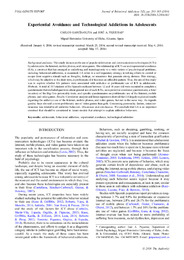Por favor, use este identificador para citar o enlazar este ítem:
https://hdl.handle.net/11000/35951Registro completo de metadatos
| Campo DC | Valor | Lengua/Idioma |
|---|---|---|
| dc.contributor.author | GARCÍA OLIVA, CARLOS | - |
| dc.contributor.author | Piqueras, Jose A | - |
| dc.contributor.other | Departamentos de la UMH::Psicología de la Salud | es_ES |
| dc.date.accessioned | 2025-03-12T13:03:44Z | - |
| dc.date.available | 2025-03-12T13:03:44Z | - |
| dc.date.created | 2016-07-01 | - |
| dc.identifier.citation | Journal of Behavioral Addictions 5(2), pp. 293–303 (2016) | es_ES |
| dc.identifier.issn | 2063-5303 | - |
| dc.identifier.issn | 2062-5871 | - |
| dc.identifier.uri | https://hdl.handle.net/11000/35951 | - |
| dc.description.abstract | Background and aims: This study focuses on the use of popular information and communication technologies (ICTs) by adolescents: the Internet, mobile phones, and video games. The relationship of ICT use and experiential avoidance (EA), a construct that has emerged as underlying and transdiagnostic to a wide variety of psychological problems, including behavioral addictions, is examined. EA refers to a self-regulatory strategy involving efforts to control or escape from negative stimuli such as thoughts, feelings, or sensations that generate strong distress. This strategy, which may be adaptive in the short term, is problematic if it becomes an inflexible pattern. Thus, the aim of this study was to explore whether EA patterns were associated with addictive or problematic use of ICT in adolescents. Methods: A total of 317 students of the Spanish southeast between 12 and 18 years old were recruited to complete a questionnaire that included questions about general use of each ICTs, an experiential avoidance questionnaire, a brief inventory of the Big Five personality traits, and specific questionnaires on problematic use of the Internet, mobile phones, and video games. Results: Correlation analysis and linear regression showed that EA largely explained results regarding the addictive use of the Internet, mobile phones, and video games, but not in the same way. As regards gender, boys showed a more problematic use of video games than girls. Concerning personality factors, conscientiousness was related to all addictive behaviors. Discussion and conclusions: We conclude that EA is an important construct that should be considered in future models that attempt to explain addictive behaviors. | es_ES |
| dc.format | application/pdf | es_ES |
| dc.format.extent | 11 | es_ES |
| dc.language.iso | eng | es_ES |
| dc.publisher | Akadémiai Kiadó | es_ES |
| dc.rights | info:eu-repo/semantics/openAccess | es_ES |
| dc.rights | Attribution-NonCommercial-NoDerivatives 4.0 Internacional | * |
| dc.rights.uri | http://creativecommons.org/licenses/by-nc-nd/4.0/ | * |
| dc.subject | adolescents | es_ES |
| dc.subject | behavioral addiction | es_ES |
| dc.subject | experiential avoidance | es_ES |
| dc.subject | technological addiction | es_ES |
| dc.subject.other | CDU::1 - Filosofía y psicología::159.9 - Psicología | es_ES |
| dc.title | Experiential Avoidance and Technological Addictions in Adolescents | es_ES |
| dc.type | info:eu-repo/semantics/article | es_ES |
| dc.relation.publisherversion | https://doi.org/10.1556/2006.5.2016.041 | es_ES |

Ver/Abrir:
2016_61_Investigacion_Publicaciones_Experiential Avoidance and Technological.pdf
148,16 kB
Adobe PDF
Compartir:
 La licencia se describe como: Atribución-NonComercial-NoDerivada 4.0 Internacional.
La licencia se describe como: Atribución-NonComercial-NoDerivada 4.0 Internacional.
.png)